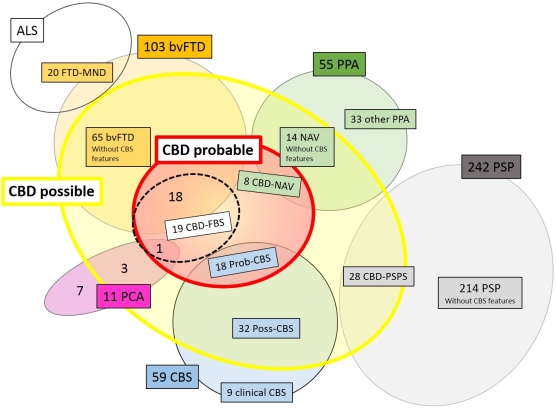Session Information
Date: Wednesday, June 22, 2016
Session Title: Phenomenology and clinical assessment of movement disorders
Session Time: 12:00pm-1:30pm
Location: Exhibit Hall located in Hall B, Level 2
Objective: To evaluate the prevalence and clinical presentation of corticobasal variants listed in the new Armstrong criteria, exploring their overlap with progressive supranuclear palsy (PSP), primary progressive aphasia (PPA), behavioral variant frontotemporal dementia (bvFTD) and posterior cortical atrophy (PCA). Neurodegenerative cerebrospinal fluid (CSF) markers were evaluated in a subgroup of patients.
Background: Recently, the Armstrong criteria listed four syndromes possibly underlying Corticobasal degeneration (CBD) pathology: the classical corticobasal syndrome (CBS), the non fluent/agrammatic variant (NAV) of PPA, the frontal behavioural-spatial (FBS) and the PSP syndromes. While these criteria have already been validated in small neuropathology-proven series including CBS and CBD mimics, their clinical applicability and overlap has never been evaluated in larger cohorts of patients.
Methods: 470 patients were enrolled with the following diagnoses: PSP (n=242), PPA (n=55), bvFTD (n=103), PCA (n=11), CBS (n=59). Patients were reclassified into CBS/CBD variants according to clinical features/symptoms. CSF total and phospho-Tau and Aβ1-42 levels were evaluated in 57 CBS/CBD and 124 PSP/PPA/bvFTD non overlapping patients.
Results: The study re-classified 45 patients as probable and 183 as possible CBD, 18 patients as probable and 32 as possible CBS, 28 out of 242 (11.5%) PSP patients as CBD-PSP and 8 out of 22 (36%) NAV patients as CBD-NAV. 80% of bvFTD and 36% of PCA subjects overlapped with FBS syndrome. CBD-FBS was diagnosed in 18 out of 103 (17.4%) bvFTD and one out of 11 (9%) PCA patients. Some features (limb rigidity, apraxia) showed a strong overlap, while others (dystonia, myoclonus, alien limb) were presented by specific CBS/CBD variants. CSF neurodegenerative markers were similar in all overlapping and non-overlapping syndromes. 14 to 30% of CBS/CBD patients presented an AD-like CSF pattern, associated with the presence of myoclonus (p=0.01).
Some features (limb rigidity, apraxia) showed a strong overlap, while others (dystonia, myoclonus, alien limb) were presented by specific CBS/CBD variants. CSF neurodegenerative markers were similar in all overlapping and non-overlapping syndromes. 14 to 30% of CBS/CBD patients presented an AD-like CSF pattern, associated with the presence of myoclonus (p=0.01).
Conclusions: A broad overlap of the new CBS/CBD variants and PSP, PPA, bvFTD and PCA was found, stressing that the application of the Armstrong criteria should not be restricted to patients with a clinical suspicion of CBS. Despite the clinical overlap, some features are obviously able to differentiate CBS/CBD variants. Longitudinal studies and autopsy are warranted to evaluate the clinical progression and the underlying pathology of the newly defined CBS/CBD subtypes.
To cite this abstract in AMA style:
A. Pilotto, W. Maetzler, M. Synofzik, E. Schaeffer, C. Schulte, M.A. Hobert, K. Srulijes, T. Gasser, D. Berg. Overlapping corticobasal syndromes: The many faces of the Armstrong criteria [abstract]. Mov Disord. 2016; 31 (suppl 2). https://www.mdsabstracts.org/abstract/overlapping-corticobasal-syndromes-the-many-faces-of-the-armstrong-criteria/. Accessed December 16, 2025.« Back to 2016 International Congress
MDS Abstracts - https://www.mdsabstracts.org/abstract/overlapping-corticobasal-syndromes-the-many-faces-of-the-armstrong-criteria/
